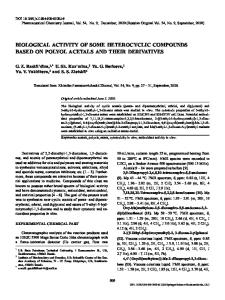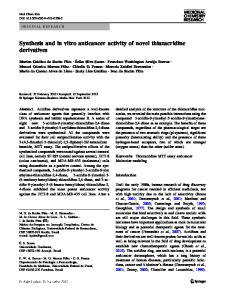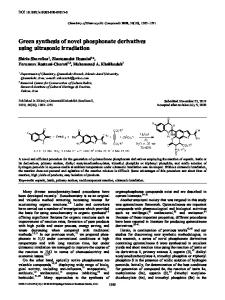Synthesis of novel macrocyclic and heterocyclic taurine derivatives based on the reaction of sodium 2-[(4,4-diethoxybuty
- PDF / 210,887 Bytes
- 4 Pages / 594 x 792 pts Page_size
- 33 Downloads / 268 Views
Synthesis of novel macrocyclic and heterocyclic taurine derivatives based on the reaction of sodium 2-[(4,4-diethoxybutyl)amino]ethanesulfonate with phenols Andrey V. Smolobochkin1*, Lola Zh. Yakhshilikova2, Almir S. Gazinov1, Liliya I. Vagapova1, Alexander R. Burilov1, Michael A. Pudovik1 1
Arbuzov Institute of Organic and Physical Chemistry, Kazan Scientific Center, Russian Academy of Sciences, 8 Akademika Arbuzova St., Kazan 420088, Russia; e-mail: [email protected] 2 Kazan National Research Technological University, 68 Karla Marksa St., Kazan 420015, Russia
Submitted March 27, 2020 Accepted April 15, 2020
Translated from Khimiya Geterotsiklicheskikh Soedinenii, 2020, 56(7), 888–891
An approach to the synthesis of novel macrocyclic and heterocyclic taurine derivatives based on the reaction of sodium 2-[(4,4diethoxybutyl)amino]ethanesulfonate with phenols in the presence of trifluoroacetic acid has been developed. The structures of the obtained products are confirmed by spectral data. Keywords: acetal, calix[4]resorcinol, phenols, pyrrolidine, taurine, trifluoroacetic acid.
At present, organic synthesis is one of the most rapidly developing areas of chemistry,1 and its achievements are being introduced into medicine, agriculture, and technology. This branch of organic chemistry has reached such a level of development that compounds of various classes can be obtained from a single substrate, depending on the chosen catalyst and reagent, as well as their quantities. Taurine is a sulfur-containing amino acid that is present in living organisms as well as animal tissues2 and plays an important role in various biological processes.3 Taurine derivatives containing the pyrrolidine ring are of particular interest due to their high pharmacological activity. Representatives of this class of compounds are dipeptidyl peptidase-4 inhibitors,4а 5-HT4 receptor agonists,4b possess anti-inflammatory and antitumor properties.4c,d The existing literature methods for the synthesis of taurine derivatives can be divided into two main groups (Scheme 1). The first is based on the opening of nitrogencontaining heterocycles. In industry, taurine is synthesized as a result of multistage processes based on ethanolamine and leading to the formation of an intermediate aziridine 0009-3122/20/56(7)-0888©2020 Springer Science+Business Media, LLC
and its further reaction with sodium sulfite in the presence of acid.5 Derivatives of 2-aminoethanesulfonic acid are obtained by opening a substituted aziridine ring.6 Thiazolidine-2-thiones7 and 1,2-thiazetidine 1,1-dioxides8 are used as heterocyclic systems for the synthesis of taurine derivatives. However, this approach is not widely used. Scheme 1
888
Chemistry of Heterocyclic Compounds 2020, 56(7), 888–891 Scheme 2
The main limitation of this method is the multistep transformations required to obtain taurine derivatives. The second group of methods is modifications of linear precursors. Within the body, taurine is formed as a result of enzymatic oxidation of cysteine.9 Substituted taurine
Data Loading...











